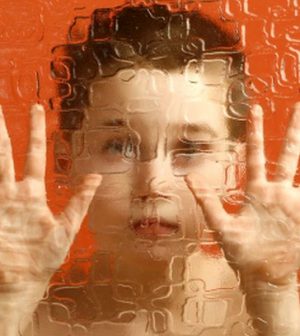- Skip Storing This Everyday Product in the Fridge Door
- Green Tea + B3 Pairing May Boost Brain Health
- Navigating Your Midlife Crisis: Embracing New Possibilities
- City Raccoons Showing Signs of Domestication
- Mapping the Exposome: Science Broadens Focus to Environmental Disease Triggers
- One Week Less on Social Media Linked to Better Mental Health
- Your Brain Changes in Stages as You Age, Study Finds
- Some Suicide Victims Show No Typical Warning Signs, Study Finds
- ByHeart Formula Faces Lawsuits After Babies Sickened With Botulism
- Switch to Vegan Diet Could Cut Your Greenhouse Gas Emissions in Half
Genes May Explain Why Kids With Autism Avoid Eye Contact

Children with autism spectrum disorders tend to avoid eye contact and look away from other people’s mouths, behaviors that are likely influenced by genetics, new research suggests.
Roughly 1 in 68 children in the United States has autism. The disorder affects how children learn, communicate and behave.
It’s common for children with autism to look away from other people’s faces. Doctors often use this behavior to help screen for the condition, according to researchers from Washington University in St. Louis and Emory University in Atlanta.
For the study, the team of scientists investigated how children’s DNA affects their ability to engage visually in social settings.
“Research shows that autism likely has a genetic basis. Siblings of children diagnosed with autism and people with certain genetic mutations have a higher risk of developing the disorder, compared to the general population,” said Dr. Diana Bianchi. She is director of the U.S. National Institute of Child Health and Human Development (NICHD).
“Understanding how genes influence social behaviors will help researchers identify new or better ways to treat autism,” Bianchi said in an NICHD news release.
For the study, Dr. John Constantino, of Washington University’s department of psychiatry, and colleagues conducted experiments that tracked the eye movements of 250 typically developing children between 18 and 24 months old.
This group of children included 41 sets of identical twins, 42 pairs of non-identical twins and 42 random pairs of unrelated children. The team also evaluated 88 children with autism who didn’t have a twin.
The children watched videos of a woman speaking directly to the viewer or scenes of children socializing at daycare.
Specially designed software detected the timing and direction of the children’s eye movements as they watched the videos. Specifically, the researchers could tell when kids were looking at the video characters’ eyes, mouth, body or nearby objects.
The study found that identical twins often had coordinated visual patterns. They shifted their eyes at the same times and in the same direction. These children tended to look at a person’s eyes or mouth at the same time.
Visual patterns were less consistent among the non-identical twins, the findings showed. Visual patterns were even less coordinated among the unrelated pairs of children.
These findings suggest that these behaviors are influenced by genetics, the researchers noted.
“By comparing identical twins who share the same genes to non-identical twins and randomly paired children who do not share the same genes, the study is one of the first to show that social visual behaviors are under genetic control,” said Lisa Gilotty. She is chief of the U.S. National Institute of Mental Health’s (NIMH) Research Program on Autism Spectrum Disorders.
Further investigation revealed the children with autism looked at eye and mouth regions much less often than the other groups of typically developing children.
The study authors suggested that more research could help uncover which genes are involved in social visual engagement, and how disorders like autism affect these pathways.
The study, which was partially funded by the NICHD and the NIMH, was published online July 12 in the journal Nature.
More information
The U.S. Centers for Disease Control and Prevention has more about autism.
Source: HealthDay
Copyright © 2025 HealthDay. All rights reserved.










